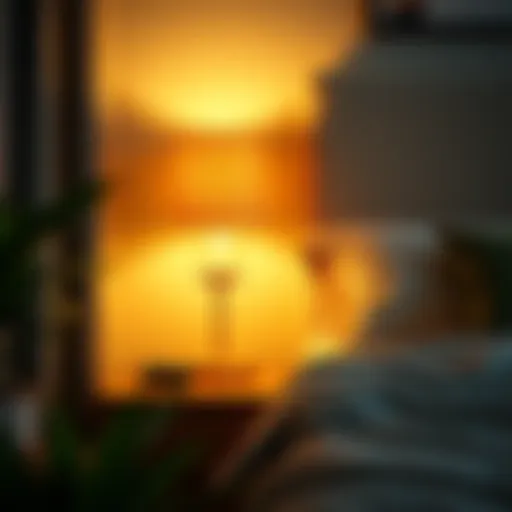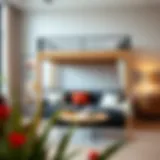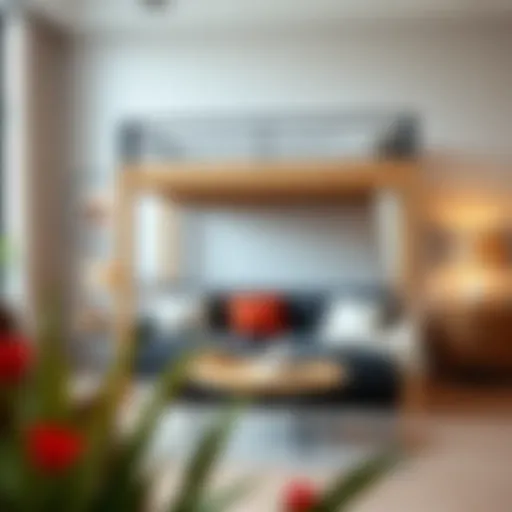Explore Roman Style Curtains for Your Interiors
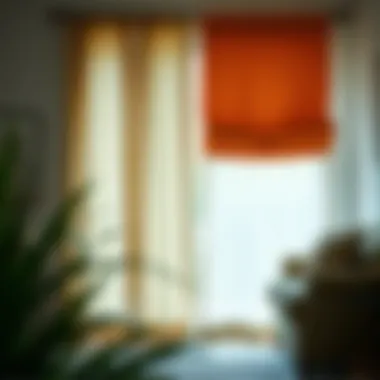

Intro
Roman style curtains, known for their effortless elegance and versatility, serve not just as window dressing but as instrumental pieces in the tapestry of interior design. As the quest for aesthetic appeal marries functionality, understanding these curtains becomes essential for homeowners and designers alike. They bring a unique blend of sophistication and practicality to both residential and commercial spaces.
In this guide, we will peel back the layers to explore various aspects of Roman curtains. From their distinctive characteristics and fabric choices to installation techniques and maintenance tips, each facet offers insight into how to effectively incorporate them into a space that speaks to both style and comfort. By the end, you'll be equipped with not only knowledge but an appreciation for how these curtains can elevate any interior setting.
Design Trends
Current Trends in Curtain Styles
Roman curtains have transcended their traditional role in design, adapting to contemporary trends that emphasize minimalism and sustainability. The current market showcases:
- Natural Fabrics: An increasing shift toward eco-friendly materials such as organic cotton and linen.
- Layering Techniques: Homeowners are experimenting with layering Roman curtains alongside sheer drapes for a more textured effect while allowing light filtration.
- Bold Patterns and Colors: While subtle tones are timeless, vibrant colors and geometric patterns are carving a niche in modern aesthetics.
- Smart Curtains: Technology integration allows for automated Roman blinds that enhance convenience along with elegance.
Adapting these trends into your space not only reflects modern sensibilities but also provides a fresh perspective.
How to Incorporate Trends into Your Space
Incorporating Roman curtains into your current decor can be as simple or elaborate as you desire. Here are practical strategies to consider:
- Choose a Focal Point: Select a vibrant fabric or distinctive pattern as the statement piece in a room, allowing it to anchor your design.
- Mix and Match: Pair Roman curtains with other window treatments. For instance, combining them with plantation shutters can create a layered appearance that's both stylish and functional.
- Think Color Scheme: Ensure the colors of your curtains harmonize with the overall color palette of your room. Secondary colors should complement rather than clash.
- Consider Fabric Weight: Lighter fabrics work well in airy spaces, while heavier fabrics can provide warmth in more intimate settings.
"The beauty of Roman curtains lies in their adaptability; they can soften the edges of modern spaces without feeling out of place."
Buying Guides
Choosing the Right Curtains for Different Rooms
When selecting Roman curtains, it's essential to consider the specific needs of each room. For instance:
- Living Rooms: Opt for durable fabrics that can withstand sunlight, allowing you to create a welcoming atmosphere without fading.
- Bedrooms: Go for blackout lining to ensure privacy and promote restful sleep. Fabrics should be inviting and soothing to the eye.
- Kitchens: Lightweight materials that can be easily washed are ideal, ensuring a clean and fresh look.
- Offices: Consider using fabrics that block glare but still allow natural light to enter, providing a comfortable working environment.
Tips for Assessing Quality and Value
When purchasing Roman curtains, it's crucial to assess both quality and value. Here’s how you can approach it:
- Check Fabric Type: Natural fibers tend to offer better durability and aesthetic than synthetic ones.
- Inspect Stitching: Quality stitching reflects good craftsmanship. Loose threads or fraying can indicate lower quality.
- Transparency: Effective Roman curtains should maintain structural integrity when raised. Ensure the fold and pattern hold well.
- Warranty and Care Instructions: A good warranty shows the manufacturer’s confidence in their product, while clear care guidelines will save you time and effort.
Understanding Roman style curtains is not merely about fabric and design assumptions; it is about recognizing their potential to transform spaces. Whether one is a seasoned designer or a DIY enthusiast, the right knowledge and attention to detail can make all the difference.
The Essence of Roman Style Curtains
Roman style curtains have a unique charm that transcends ordinary window treatments. They offer an aesthetic appeal that can elegantly complement a variety of interior design schemes, whether in a swanky urban apartment or a quaint countryside cottage. The very way they function speaks volumes about what they can contribute to a space—fusing practicality with a stylish flair.
Historical Background
The origins of Roman style curtains* can be traced back to ancient Rome, a time when opulence and artistry combined in home décor to create an ambiance of sophistication. Architects and designers in ancient Rome often used fabric to soften the harsh lines of their grand structures, leading to a trend that favored draped fabrics in window treatments. Originally made from thick woven materials, these early Roman shades were not purely decorative but served a functional purpose, blocking the sun’s harsh rays while also providing privacy in that bustling city.
As the centuries wore on, these window treatments evolved. With time, they transformed from simple pieces of cloth to intricate designs that employed diverse fabrics and styles, reflecting different eras and cultures. These transformations keep them relevant and sought-after even today, bridging the gap between past elegance and contemporary needs. From ancient villas to modern lofts, Roman curtains have long been a hallmark of refined taste. Their history encapsulates aesthetic evolution and cultural shifts, making them much more than just window coverings. They tell a story.
Design Characteristics
What makes Roman curtains stand out in today's vast array of window treatments? For starters, their unique design allows them to fold neatly into pleats when raised, a feature that neither traditional drapes nor contemporary blinds can offer. Here are key characteristics that define Roman style curtains:
- Versatile Styles: From flat to relaxed to hobbled, the different styles cater to various design preferences, ensuring that there is a suitable option for every aesthetic.
- Fabric Choices: The curtain can be made from a plethora of fabrics ranging from linen to silk, often incorporating patterns that reflect personal style.
- Clean Lines: They provide an uncluttered, streamlined look, often making them ideal for minimalist or modern settings.
- Functional Simplicity: Their mechanism, whether using a cord or a more contemporary system, keeps the operation straightforward, allowing ease of use without sacrificing design elegance.
As you consider Roman style curtains, it’s essential to think about not just their appearance but their functionality—how they balance light control and privacy while enhancing the room's overall ambiance.
"Roman style curtains are not just about window dressing; they are a full-fledged design statement that can anchor the entire room's aesthetic."
In essence, Roman curtains encapsulate history, functionality, and style in a single, sophisticated package.
Materials and Fabrics
When it comes to Roman style curtains, selecting the right materials and fabrics is vital. The essence of these curtains lies not only in their aesthetic appeal but also in their functionality, which is largely dictated by the choice of material. Different fabrics can set a specific mood for a room, influence how light interacts with the space, and most importantly, affect the maintenance and longevity of the curtains.
Common Fabric Choices
A plethora of fabric options exists for Roman style curtains, each offering distinct advantages:
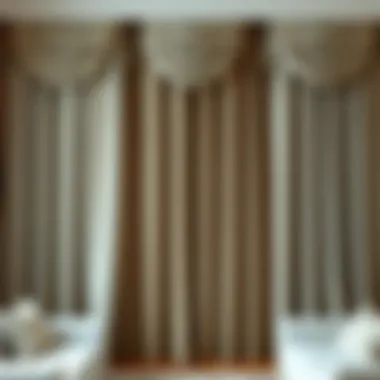

- Cotton: Known for its ease of maintenance, cotton is a go-to choice for those who prioritize practicality without skimping on style. It’s breathable and available in countless patterns and textures, making it versatile for any decor.
- Linen: Linen conveys a natural and elegant vibe. It tends to be lightweight and airy, perfect for spaces where you want to softly diffuse natural light. Keep in mind, though, it can wrinkle easily.
- Silk: If luxury is what you're after, silk is the fabric that delivers. While it requires more care, its sheen can amp up sophistication in any room. Just be careful with sunlight; prolonged exposure can fade and damage it over time.
- Polyester: Offering durability and stain resistance, polyester is ideal for busy households or commercial spaces. It mimics the look of the more expensive materials but at a fraction of the cost.
Choosing the right fabric boils down to the specific needs of your environment. For example, if a room experiences a lot of sunlight, you may want to avoid silk since it can fade. Similarly, in a kid's room, the durability of polyester becomes more important.
Sustainable Options
As the conversation around sustainability gains traction, many are opting for eco-friendly fabrics for their Roman curtains. These not only contribute to a healthier planet but can also enhance the aesthetic of a space.
- Recycled Materials: Curtains made from recycled fibers are becoming popular. They reduce waste and often retain the quality of new materials. Brands are increasingly creating stunning designs using these textiles, offering an elegant yet sustainable choice.
- Organic Cotton: This is a step up from conventional cotton. Produced without harmful pesticides, it’s a safer option for those concerned about chemical exposure. Plus, it's often softer, making it a delightful choice for any curtain.
- Bamboo Fabric: Bamboo is a fast-growing plant that requires minimal resources to cultivate. Curtains made from bamboo fibers tend to be soft with a natural sheen, adding a distinctive touch to home decor.
Opting for sustainable materials does not mean compromising on style. These fabrics often come in a range of designs, from simple to intricate, allowing homeowners to match their curtains with personal taste.
"Choosing the right fabric is not just about aesthetics; it’s about making a choice that resonates with your lifestyle."
When planning to invest in Roman style curtains, dive into the material options available. Think about how fabric impacts light, maintenance, and the overall vibe of your space. Whether you lean towards luxurious silk or eco-friendly bamboo options, remember that the right choice can elevate not just your windows, but the entire room.
Types of Roman Curtains
When considering Roman style curtains, understanding the different types available is crucial for selecting the ideal design that fits your space. Each type serves a purpose influenced by both functionality and artistic expression, thereby enhancing the overall atmosphere of the room. Let’s dive deeper into two prominent categories: single panel and double panel designs, alongside their blackout and light filtering variants.
Single Panel vs. Double Panel Designs
The choice between single panel and double panel Roman curtains can drastically alter the ambiance in any room. A single panel design often highlights simplicity. These curtains are usually easier to operate, making them a practical choice for spaces that require frequent opening and closing. They provide an unobstructed view when fully raised, allowing natural light to flood into your home.
Conversely, double panel designs offer a richer visual aesthetic. They create a fuller look when closed and, depending on the fabric choice, can enhance the insulation properties of the curtains. When opting for double panels, consider the additional width needed for proper gathering of the fabric. The added material can also contribute to a more luxurious feel in the space.
"Always measure your space meticulously to ensure that the curtains fit just right—too long or too short can throw off the entire design!"
In practical terms:
- Single Panel:
- Double Panel:
- Easier maintenance
- Better for smaller windows
- Minimal fabric needed
- Enhanced aesthetic and fullness
- Better insulation properties
- Requires more space and fabric
Blackout and Light Filtering Variants
When it comes to the functionality of Roman curtains, the distinction between blackout and light filtering variants cannot be overlooked. Choosing the right style here hinges on your unique needs for light control and privacy. Blackout Roman curtains are typically made from tightly woven fabrics or sometimes even lined with a light-blocking material. They are a perfect solution for bedrooms, media rooms, or any space where complete darkness is desired. These curtains work wonders at blocking out sunlight, thereby improving the quality of sleep and creating a cozy ambiance.
On the other hand, light filtering Roman curtains allow natural light to gently diffuse into the room while still offering some privacy. They are often made from lighter materials that showcase patterns and textures, adding a decorative touch to your interiors. This option is ideal for living areas or kitchens where you might want to enhance brightness without sacrificing your view.
Key distinctions include:
- Blackout Curtains:
- Light Filtering Curtains:
- Completely blocks out light
- Ideal for bedrooms and media rooms
- Helpful for energy efficiency by keeping the room cool
- Allows soft light to enter
- Enhances the aesthetics with patterns and softness
- Suitable for living rooms and kitchens
Understanding these variants will help you make an informed decision, ensuring your Roman curtains not only match your style but also meet the functional needs of your space.
Functional Benefits
Roman style curtains are not just a pretty face. They bring a slew of functional benefits that enhance the practicality of any room, making them more than just a decorative addition. Whether you are a homeowner, designer, or DIY enthusiast, understanding these benefits allows for a more informed selection process when considering Roman curtains for your interior spaces.
Light Control
One of the standout features of Roman curtains is their ability to manage light entering a room. With the right fabric, these curtains can allow a gentle flow of light, creating a warm and inviting atmosphere. Conversely, if you require more darkness—perhaps for a bedroom or a media room—choosing blackout fabric variants can effectively block out external light.
This control extends beyond mere aesthetics; light management can significantly influence energy consumption. For instance, in summer, lighter fabric can diffuse harsh sunlight, reducing the need for artificial cooling. Meanwhile, during winter, a closed Roman curtain can help retain warmth, minimizing heating costs.
Privacy Enhancement
Privacy is paramount in a comfortable home environment. Roman curtains provide an elegant solution for securing personal space without compromising style. When fully drawn, they offer a barrier that shields your home from prying eyes, allowing you to unwind without feeling vulnerable.
For city dwellers or homes across the street from neighbors, this feature is particularly important. It’s about creating a sanctuary within your walls. Plus, Roman curtains can be designed to coordinate with your interior decor, harmonizing with your style preferences while ensuring your privacy remains intact.
Energy Efficiency
In today’s eco-conscious world, energy efficiency is key. Roman curtains contribute meaningfully to this aspect of home design. By optimizing insulation, they can reduce energy costs throughout the seasons. During sweltering days, closed curtains can keep rooms cool, and conversely, they can help trap heat during colder months.
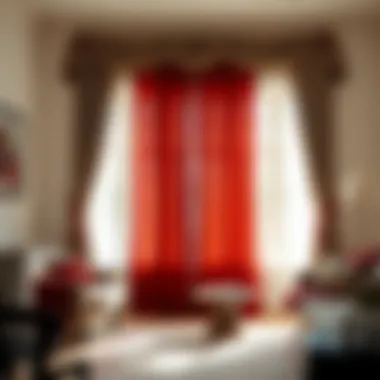

This dual functionality ensures that not only are you keeping your home comfortable, but also reducing the strain on heating and cooling systems. This is especially relevant for those who are keen on sustainable living or looking to lower energy costs. Maintaining a temperate home with Roman curtains can blend aesthetic appeal with practical needs.
As you explore the various aspects of Roman curtains, remember that the choices you make can greatly impact both your comfort and your energy bills.
"A thoughtful selection of window treatments, like Roman curtains, serves as a practical investment in your home’s comfort and style."
By understanding these functional benefits, you’re equipped to make well-informed decisions that elevate your living or working space. For more tips on how to optimize your interior design, consider checking out resources from Wikipedia, or consult design forums on Reddit for community insights.
Customization and Personalization
In the realm of interior design, customization and personalization stand as pillars of creating spaces that genuinely reflect individual aesthetics and lifestyles. When it comes to Roman style curtains, these elements are not just additional enhancements; they are crucial to achieving the desired ambiance and functionality in your setting. The process of selecting the right colors, patterns, and measurements allows for curtains that not only fit the windows but also complement the overall decor, making the space feel cohesive and thoughtfully designed.
Customization in Roman curtains embodies the idea that every living space can be a true extension of its inhabitants. It embraces variations that allow the homeowner to express uniqueness and style through textiles and designs. For instance, consider a vibrant geometric pattern that energizes a minimalist living room or a soft pastel hue that calms a bedroom's atmosphere. Each choice influences the visual dynamics of the space.
Color and Pattern Selection
Selecting colors and patterns is arguably one of the most significant aspects of customizing Roman style curtains. The right color can set the mood of a room—bright, bold colors tend to add vibrancy, while muted tones offer subtlety and tranquility. It's crucial to think about not only the color you love but also how it interacts with surrounding elements.
Here are some key factors to consider when choosing colors and patterns for your Roman curtains:
- Complementary Colors: Ensure that the selected hue complements the walls, furniture, and other decor. Use a color wheel for inspiration.
- Room Functionality: Think about the purpose of the room. Bright, lively patterns might work wonders in a playroom, while soft tones could be more appropriate for a home office.
- Personal Taste: Your choice should resonate with your personality. Whether bold floral designs speak to you or simple stripes fit your taste, embrace your preferences.
When planning patterns, balance is essential. Avoid overcrowding the space with competing motifs. Instead, consider using solid curtains in a striking color paired with patterned pillows or throws for a harmonious appearance.
Tailored Measurements
Tailored measurements are integral to ensuring that Roman curtains fit perfectly within your window space. The tailored approach doesn’t just serve practicality; it also heightens the aesthetic impact of the curtains. Ill-fitting curtains can detract from the elegance you seek to achieve. Here’s a rundown of why proper measurements are paramount:
- Precision Fit: Custom measurements ensure that the curtains fit snugly, avoiding gaps and eliminating the risk of light peeking through where it shouldn’t.
- Proportionality: The size of the curtains should align with the proportions of the room. Overly long or short curtains can disrupt the visual flow and create an unbalanced appearance.
- Functionality: Well-measured curtains hang correctly, allowing for smooth operation. This translates into easier raising and lowering, essential for day-to-day use.
Take the time to measure each window accurately. Use a metal tape measure for precision, and always take multiple readings to account for any irregularities. Accounts for brackets or hardware adds another layer to the essential measurements.
Customization and personalization in Roman style curtains are about striking a balance between aesthetic desires and practical realities. Every choice—from color and pattern to measurements—plays a critical role in the development of a space that is not only beautiful but also resonates with the identity of its inhabitants.
Installation Techniques
When it comes to Roman style curtains, knowing how to install them properly is just as crucial as selecting the right fabric or design. The effectiveness of these curtains in enhancing a room's aesthetic and functionality directly hinges on a sound installation technique. This section outlines the tools needed and provides a thorough step-by-step installation guide. Getting this right not only saves time but also ensures that the curtains operate smoothly, allowing you to control light and privacy effectively.
Tools Required
Before jumping into the installation process, it's essential to gather the right tools. Having everything on hand can make the entire experience smoother. Here's a list of what you might need:
- Measuring Tape: For precise measurements of your window and curtain width.
- Level: To ensure that your curtain rod is installed straight. A crooked rod could ruin the whole look.
- Drill or Screwdriver: Depending on how your brackets will be mounted.
- Brackets: Make sure they are compatible with your rod and can support its weight.
- Curtain Rod: The essential element to hang your beautiful Roman curtains.
- Pencil: To mark where you’ll install brackets without causing damage to your walls.
Step-by-Step Installation Guide
Installing Roman curtains may seem daunting at first, but by breaking it down, it becomes a manageable task. Follow these steps for a successful installation:
- Measure Your Window: Start by measuring the width of your window, adding a few extra inches if you want more coverage. Do this from one side to the other and record the figure.
- Mark the Bracket Placement: Use the pencil to mark where you want to place the brackets. Typically, the brackets should be placed about 4-6 inches above the window frame and at least 3-4 inches wider than the window on each side.
- Check for Level: Once marked, use the level to ensure precision before proceeding. If any marks are off more than a tad, adjust accordingly.
- Drilling Holes: Carefully drill holes into the marked spots on your wall. Make sure to use wall anchors if you're drilling into drywall for a firmer hold.
- Install the Brackets: Securely fasten the brackets into place using your screwdriver or drill. Double-check that they’re lined up evenly and attached firmly.
- Hang the Curtain Rod: Place the rod into the installed brackets, ensuring it is secure. It's always good to have a partner for this step, just to keep things steady.
- Attach Your Roman Curtains: Finally, follow the manufacturer’s instructions to attach your Roman curtains to the rod. Adjust them as necessary to achieve your desired look.
Always remember: Proper installation not only affects the functionality of your Roman curtains but also plays a pivotal role in maintaining their aesthetic appeal. A well-installed set of curtains can elevate the overall feel of a room, making it cozy and inviting.
By mastering these installation techniques, homeowners and designers alike can optimize the functionality and beauty of Roman curtains. Becoming confident in execution allows room for creativity in design choices, ensuring that each installation reflects personal style.
Maintenance and Care
Maintaining the beauty and functionality of Roman style curtains is not just about keeping up appearances; it’s about prolonging their life and ensuring that they serve their purpose effectively. Roman curtains, known for their elegant fold-and-drape style, can be a tad high maintenance compared to other window treatments. However, with the right approach to care, homeowners can keep these exquisite draperies looking as good as new for years to come.
Regular upkeep can prevent the buildup of dust and grime, which can affect both the aesthetic and the fabric integrity. Not to mention, a well-cared-for curtain can significantly enhance the overall ambiance of any room. So, let’s dive into some essential aspects of cleaning and repair that cater specifically to these stylish window treatments.
Cleaning Techniques
When it comes to cleaning Roman curtains, one of the cardinal rules is to always check the care label. Fabrics have unique requirements; thus, knowing how to care for each variant is paramount.
Here are some effective techniques:
- Dusting Regularly: Use a soft brush or vacuum attachment with a low suction setting to remove dust build-up. Regular dusting can help keep your curtains fresh and vibrantly colored.
- Spot Cleaning: For minor stains, a damp cloth and mild detergent can work wonders. Gently dab, not rub, on the stained area to avoid spreading the stain.
- Machine Washing: If the fabric is machine washable, use a gentle cycle with cold water. Always place the curtains in a laundry bag to reduce friction and tearing. After washing, avoid wringing the fabric, and instead lay it flat or hang it to dry.
- Professional Cleaning: For delicate fabrics, like silk or those with intricate patterns, it's often best to leave the cleaning to professionals. Dry cleaning services understand how to handle and maintain these sensitive materials effectively.
Repairing Common Issues
Despite your best efforts, wear and tear can occur, especially in heavily-used curtains. Addressing issues promptly can prevent more significant problems down the line. Here are some common repairs and how to tackle them:
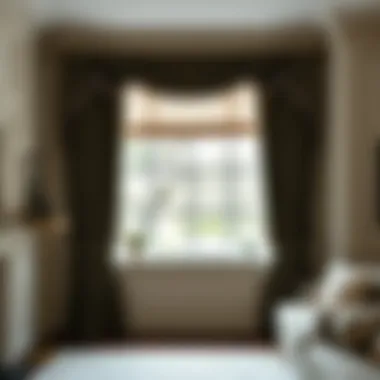

- Hemming Unravelling Edges: If the hem starts fraying, a simple sewing solution is to stitch it back in place. Use a needle and thread that matches the fabric’s color to maintain a seamless appearance.
- Reattaching Rings and Clips: If a ring or clip comes loose, don’t fret. Using a sturdy adhesive or thread is often sufficient to reattach. Just ensure to reinforce it in a way that can handle the fabric's weight.
- Ironing Folds: Sometimes, folds may look limp after washing. Lightly steaming or ironing the curtains on a low setting can restore their crispness, but always check if the fabric can withstand heat.
- Dealing with Rod Problems: If the curtain rod is damaged or not functioning smoothly, it may be worth checking whether lubrication can fix the sliding mechanism. If not, consider replacing the rod altogether.
Remember: Performing regular maintenance not only preserves the visual appeal and functionality of your curtains but can save you the extra effort and dollars for replacements.
Maintaining Roman style curtains requires an understanding of the specific fabric and design used. With diligent care and timely repairs, these curtains can continue to be a stunning feature in any interior, balancing elegance with practicality.
Roman Curtains in Various Design Styles
Roman curtains are an elegant solution for both urban apartments and rustic country homes. Their versatility allows them to transcend different design styles effortlessly. This section elaborates on how Roman curtains can be adapted to fit contemporary, traditional, and eclectic design approaches. Understanding these styles can help homeowners and designers enhance not only the aesthetics but also the functionality of their spaces.
Contemporary Approach
In modern interiors, simplicity is key. A contemporary approach to Roman curtains emphasizes clean lines, minimalistic patterns, and a harmonious color palette. Here, the focus is often on making a statement without overwhelming the overall decor. For instance, choosing a single fabric in a muted hue can complement sleek furniture while adding warmth to the room. Light-filtering fabrics are particularly popular in contemporary settings since they allow natural light to pour in, creating an open feel.
- Considerations for contemporary Roman curtains:
- Fabric: Look for textured finishes like linen blends or soft sheers.
- Colors: Neutral tones often work best—think whites, grays, or soft pastels.
- Installation: Using sleek rod systems that offer a juxtaposition of modern aesthetic with practical functionality.
An exemplary implementation could be high-rise apartments where panoramic city views are aplenty. The addition of Roman curtains, in a sheer fabric, can enhance the spaciousness while providing soft privacy from the outside world. This balance between light and privacy resonates with the ethos of contemporary design.
Traditional Settings
Traditional design thrives on the classic and ornate. When incorporating Roman curtains in such environments, homeowners should strive to evoke a sense of coziness and historical richness. Fabrics like brocade or damask can be employed, often showcasing intricate patterns that reflect the craftsmanship of bygone eras. Rich, deep colors such as burgundy, emerald green, or navy can significantly contribute to the ambiance.
- Key elements for traditional Roman curtains:
- Patterns: Florals, paisleys, or classic stripes can add a touch of nostalgia.
- Trimmings and Accents: Tassels and ornate curtain rods help create a finished look.
- Layering: Using underlays like sheers with heavier fabrics can enhance depth.
In a traditional dining room, for instance, pairing sumptuous Roman curtains with plush upholstery mirrors the attention to elegance and detail characteristic of this style. The curtains serve as a focal point, emphasizing architectural elements like moldings or window frames.
Eclectic Spaces
Eclectic spaces encourage a bold expression of personality. Mixing different styles, colors, and textures is paramount in these environments. Roman curtains can either blend seamlessly with various themes or serve as a contrast. The idea here is to experiment—maybe using a patterned fabric with splashes of color that draws attention without clashing.
- Aspects to consider in eclectic design:
- Mixing Textures: Combine different materials such as velvet and lace to create visual interest.
- Unique Patterns: Geometric designs, tribal prints, or abstract motifs can work well.
- Color Harmony: Ensure the colors, while varied, have some common tones to maintain cohesion.
For an eclectic living room filled with vintage finds and contemporary art, Roman curtains in an unexpected but complementary print can tie the diverse elements together. They can balance bold colors or graphic lines found in furniture and decor, bringing a sense of unity to the visual chaos.
"The beauty of Roman curtains lies in their adaptability, making them suitable for various design styles while enhancing the aesthetic integrity of a space."
Whether one leans toward the sleek lines of contemporary decor, the ornate details in traditional settings, or the carefree spirit of eclectic rooms, Roman curtains hold a significant place in elevating design narratives, providing both aesthetics and practical function.
Complementary Decor
Roman style curtains are not just an isolated element in a room; they are part of a holistic design approach. When selecting curtains, their relationship with complementary decor can significantly impact not only the room’s aesthetic quality but also its functionality. Understanding how roman curtains interact with other design elements can lead to a more cohesive and polished outcome in your living spaces.
Pairing with Other Window Treatments
When it comes to window treatments, choosing the right match can make all the difference. Roman curtains pair beautifully with various other options, enhancing both style and function. Consider layering your roman curtains with sheer panels; this not only allows for flexibility regarding light control but also adds an intriguing visual depth to your windows.
- Layering: This technique involves placing sheers underneath the roman curtains. It creates a soft look during the day while maximizing privacy and light control when the roman styles are pulled down.
- Combining with Blinds: If your space demands functional versatility, roman curtains can be teamed up with blinds. This combination is favorable for achieving near-total blackout at night while still maintaining a stylish silhouette during the day.
- Style Synchronization: It's essential that the accompanying window treatment shares a similar aesthetic language with the roman curtains. For instance, if the curtains have a modern geometric pattern, consider blinds or sheers with complementary shapes or colors.
“The right combination can turn a simple window into a statement piece.”
Incorporating Soft Furnishings
In the realm of interior design, soft furnishings play a critical role. They serve to harmonize your space, adding warmth and texture that is essential for comfort. Integrating soft furnishings alongside roman curtains can elevate the entire ambiance of a room.
- Cushions and Throws: Use cushions or throws in colors or textures that mimic or complement the roman curtain fabric. This creates a unified look and enhances the cozy aspect of your living spaces. For example, a bold patterned roman curtain might be beautifully offset by solid color cushions that mirror tones from the curtain.
- Rug Selection: A well-chosen rug can enhance the overall look of a room, tying the curtains and other furnishings together. For example, if the roman curtains favor an earthy palette, consider a rug that incorporates various shades of brown or green.
- Furniture Choices: The style and color of your furnishings should also echo the palette created by your roman curtains. If they’re light and airy, opt for lighter wooden furniture or fabric-covered pieces to maintain a sense of openness.
The synergy between roman curtains and complementary decor is not merely a matter of preference but rather a nuanced balance of color, texture, and form. By paying careful attention to these relationships, homeowners and designers alike can create spaces that not only look good but also feel cohesive and inviting.
Epilogue
In wrapping up our exploration of Roman style curtains, it's essential to underscore their importance not just as mere fabric drapes, but as key players in the symphony of interior design. These curtains blend functionality with aesthetics, serving several vital roles in both residential and commercial spaces. They can dramatically influence the mood of a room, providing elegance and sophistication while also being practical in controlling light and privacy.
Final Thoughts on Roman Curtains
Roman curtains epitomize what it means to marry beauty with utility. Their ability to elevate a space cannot be overstated. Consider the range of options available—from fabrics to patterns, the choices are virtually limitless, allowing for personal expression and customization. Homeowners and designers alike can experiment, mixing them with various styles to achieve the desired look.
- Aesthetic Impact: The cascading folds of Roman curtains introduce depth and texture to any room. This simple addition can make a stark space feel warm and inviting.
- Versatility: They work harmoniously in both contemporary and traditional settings, adaptable to any decor scheme. Whether paired with minimalist furniture or ornate antiques, Roman curtains can either complement or contrast effectively.
- Practical Benefits: Beyond aesthetics, they provide practical benefits such as energy efficiency and noise reduction. Their insulating properties help maintain temperature, which is a boon for energy-conscious homeowners.
In essence, integrating Roman curtains into your interior design not only enhances your home’s visual appeal but also serves practical purposes that can enrich life within those walls. As you make choices about style and fabrics, remember that the right Roman curtains can truly transform a space, reflecting personal taste while meeting functional needs.
For more insightful information on home decor, you might want to explore resources like Wikipedia or Britannica.
Discovering the perfect Roman curtain is akin to finding the right piece of art; it requires contemplation, understanding your environment, and making informed choices that resonate with your lifestyle.







